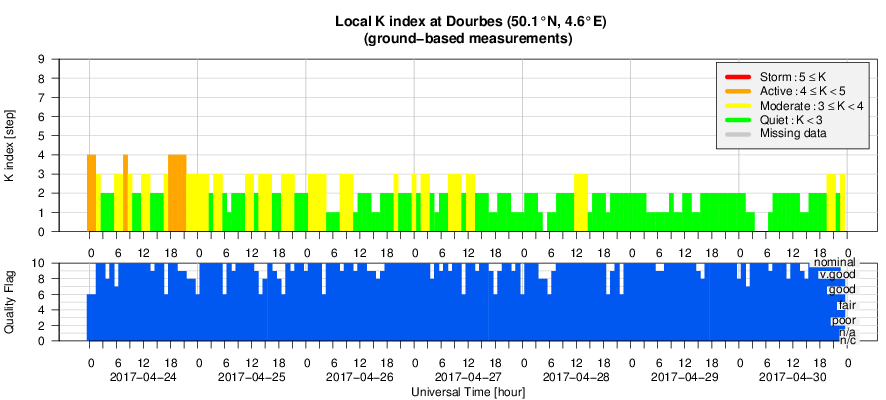- Table of Content
- 1.ESWW medal awa...
- 2.PROBA2 Observa...
- 3.Review of sola...
- 4.The Internatio...
- 5.Geomagnetic Ob...
- 6.Review of iono...
- 7.Future Events
2. PROBA2 Observations (24 Apr 2017 - 30 Apr 2017)
3. Review of solar and geomagnetic activity
4. The International Sunspot Number
5. Geomagnetic Observations at Dourbes (24 Apr 2017 - 30 Apr 2017)
6. Review of ionospheric activity (24 Apr 2017 - 30 Apr 2017)
7. Future Events
ESWW medal awards: nominate a winner
Dear colleagues
We are happy to announce the 2017 contest for the international space weather medals. The new medal recipients will be announced in a medal ceremony at the European Space Weather Week, the 27th of November, 2017.
All three prizes (Chizhevsky, Nicolet, Birkeland) are prestigious recognitions of recipients' major contributions in the field of space weather. Medal recipient's work must have been documented in peer review journals or book chapters, or must be a technological contribution that has led to a fully implemented new space weather capability. Medal recipient's work must be relevant to space weather and/or space climate. The work must also be internationally recognized.
Please find the necessary informations (how to nominate...) at http://www.stce.be/esww14/medals.php
We encourage all of you to think about potential nominees.
Best regards
The SW Medal Committee
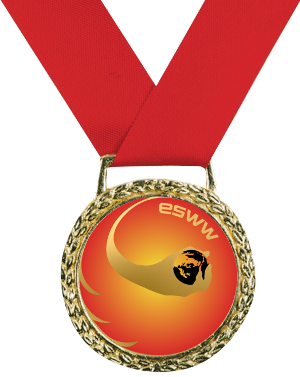
PROBA2 Observations (24 Apr 2017 - 30 Apr 2017)
Solar Activity
Solar flare activity was very low during the week.
In order to view the activity of this week in more detail, we suggest to go to the following website from which all the daily (normal and difference) movies can be accessed: http://proba2.oma.be/ssa
This page also lists the recorded flaring events.
A weekly overview movie can be found here (SWAP week 370).
http://proba2.oma.be/swap/data/mpg/movies/weekly_movies/weekly_movie_2017_04_24.mp4
Details about some of this week’s events, can be found further below.
If any of the linked movies are unavailable they can be found in the P2SC movie repository here
http://proba2.oma.be/swap/data/mpg/movies/
Monday Apr 24
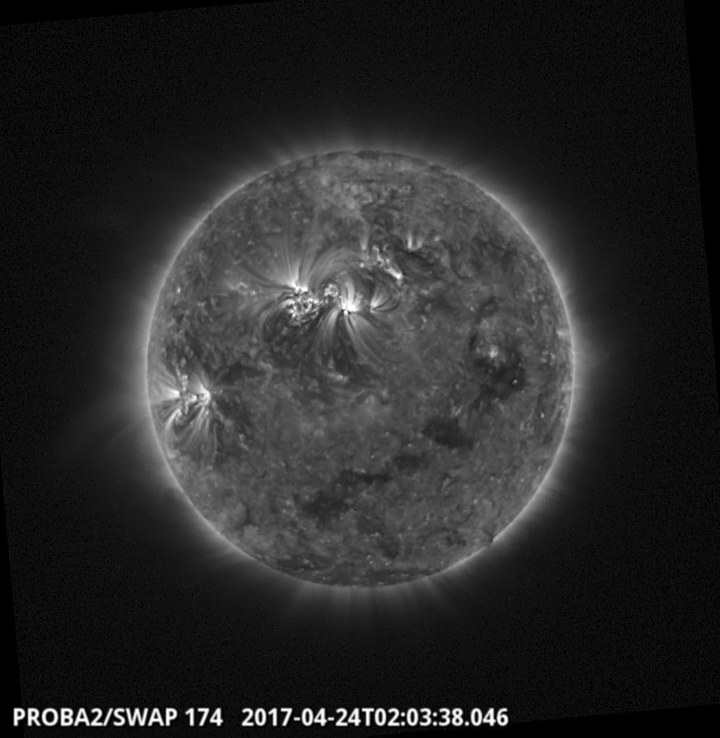
A filament eruption, from the north-east quadrant of the Sun, observed at
about 02:00 UT on 24-April-2017 was associated with a narrow CME
Find a movie of the event here (SWAP movie)
http://proba2.oma.be/swap/data/mpg/movies/20170424_swap_movie.mp4
Tuesday Apr 25
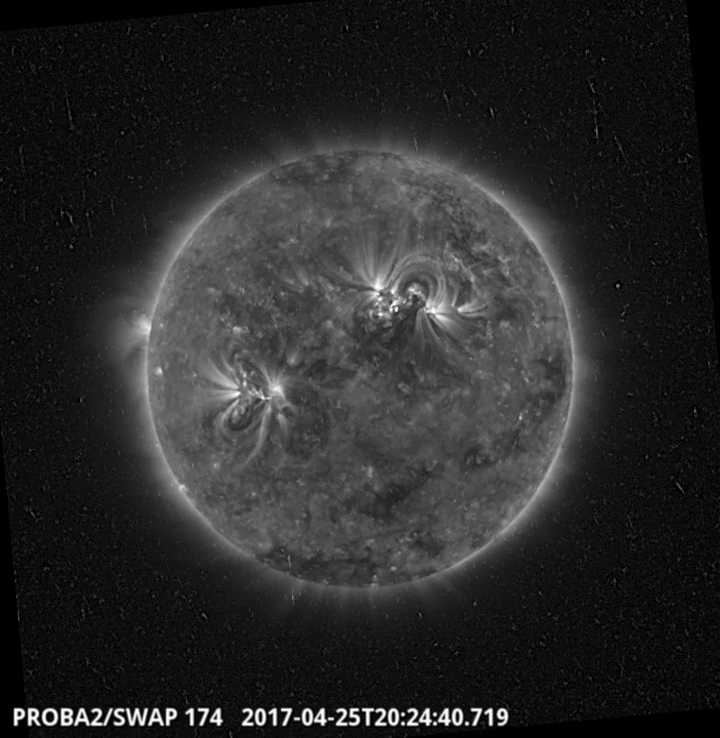
The largest flare of the week was a B7.2 class flare, peaking at 20:25 UT on 2017-Apr-25 produced by the NOAA region 2651, which is visible in the North hemisphere of the above SWAP image
Find a movie of the events here (SWAP movie)
http://proba2.oma.be/swap/data/mpg/movies/20170425_swap.mp4
Sunday Apr 30
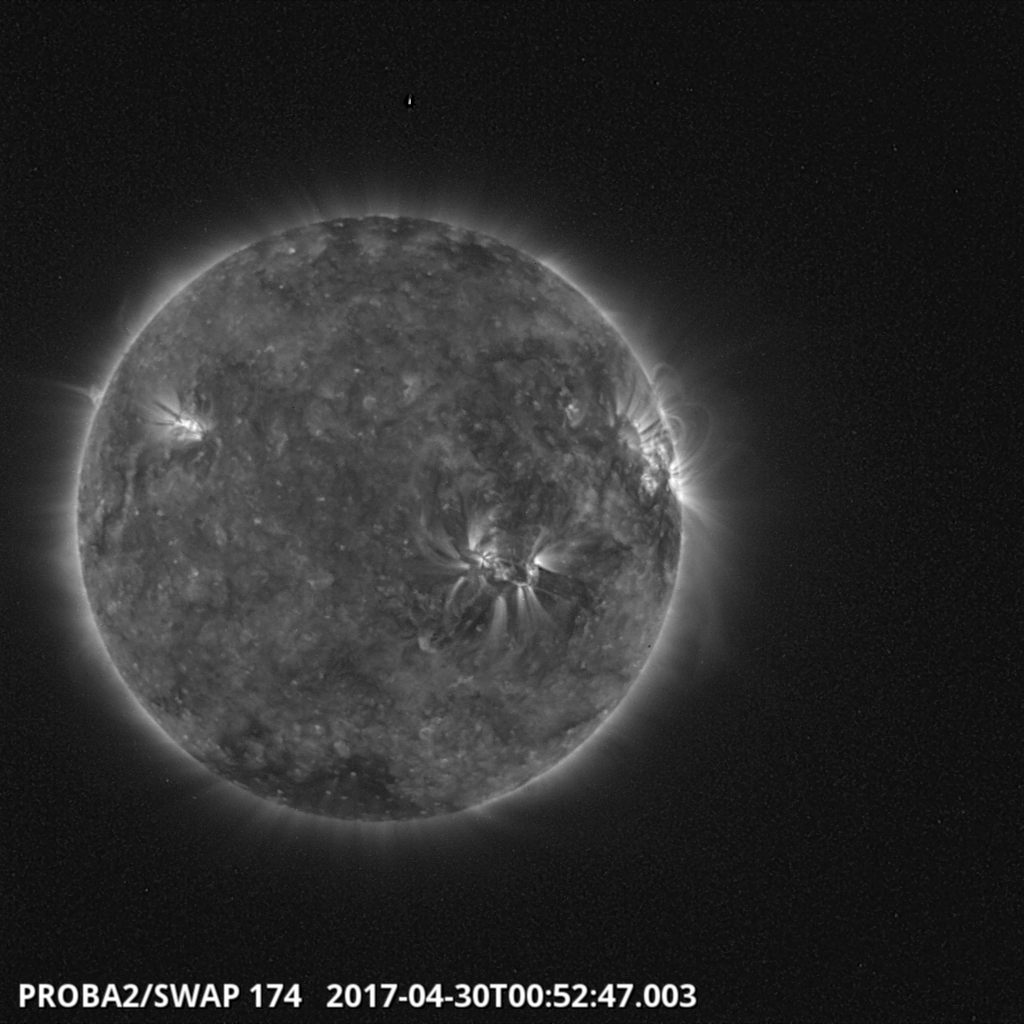
A long duration B3.0 class flare peaking at 00:57 UT on 30-April-2017 originated from the NOAA AR 2653, which is visible in the South West hemisphere of the above SWAP image. The flare was associated with an EIT wave, coronal dimming and CME.
Find a movie of the events here (SWAP movie)
http://proba2.oma.be/swap/data/mpg/movies/weekly_movies/weekly_movie_2017_04_24.mp4
Review of solar and geomagnetic activity
SOLAR ACTIVITY
During this week solar activity was very low with 14 B-class and no C-class flares reported. The flares originated from the NOAA active regions 2651, 2652 and 2653 which were the only active regions observed on the solar disc during first five days of the week.
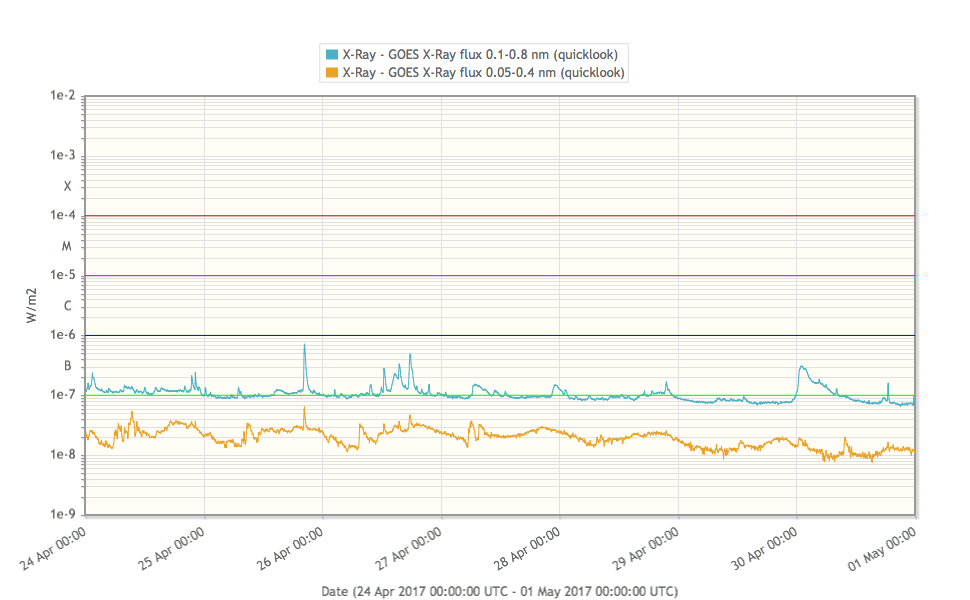
The CME associated with the filament eruption observed on April 24 at about 02:00 UT was a wide CME. It was first time seen in the SOHO/LASCO C2 field of view at 03:36 UT, and had an angular width of about 120 degrees. The bulk of the CME mass was directed mostly northward of the Sun-Earth line, so the CME is not expected to arrive at the Earth.
No significant coronal holes were observed crossing the central meridian this week.
GEOMAGNETIC ACTIVITY
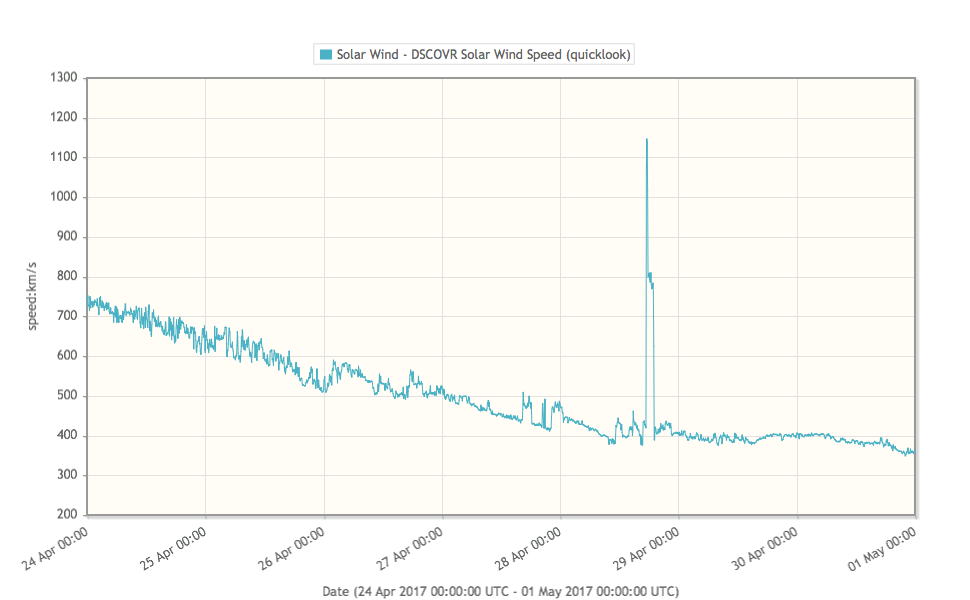
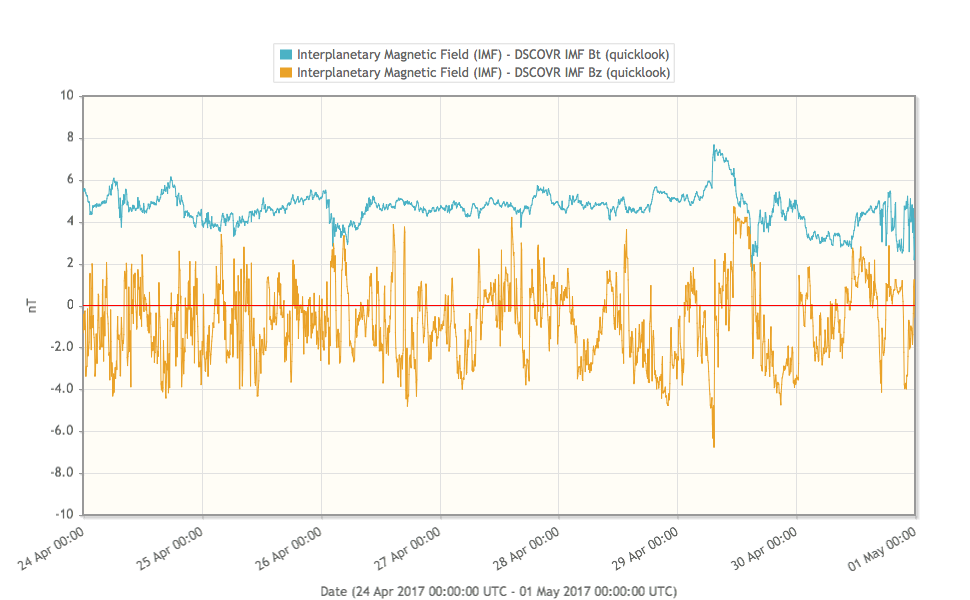
At the beginning of the week the Earth was inside a fast solar wind which on Monday 24, amounted about 720 km/s. The solar wind speed was slowly decreasing during the week and since late April 27, the Earth was inside the slow solar wind. Due to the fast solar wind and longer intervals of the negative value of the Bz component of the magnetic field, during first day of the week, unsettled to active geomagnetic conditions were reported (local station at Dourbes reported values of K=4 and NOAA reported Kp=4). The rest of the week geomagnetic conditions were unsettled to mostly quiet.
The International Sunspot Number
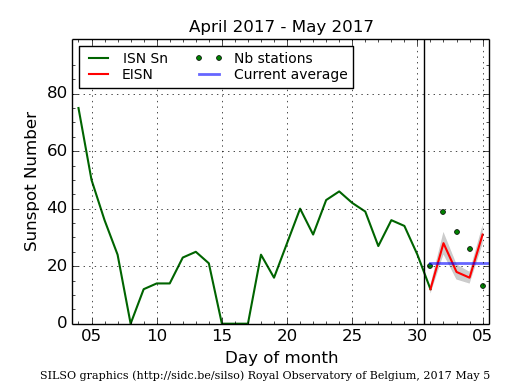
The daily Estimated International Sunspot Number (EISN, red curve with shaded error) derived by a simplified method from real-time data from the worldwide SILSO network. It extends the official Sunspot Number from the full processing of the preceding month (green line). The plot shows the last 30 days (about one solar rotation). The horizontal blue line shows the current monthly average, while the green dots give the number of stations included in the calculation of the EISN for each day.
Review of ionospheric activity (24 Apr 2017 - 30 Apr 2017)
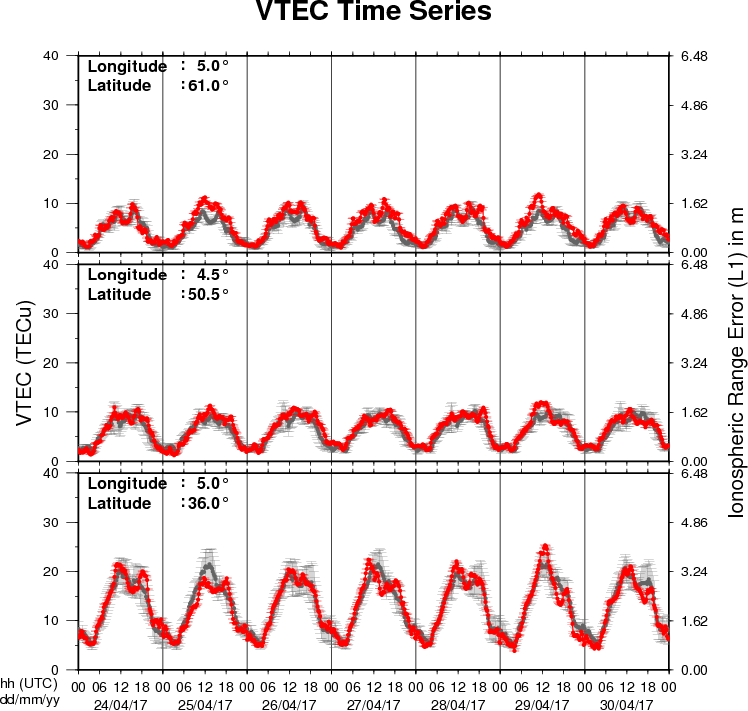
The figure shows the time evolution of the Vertical Total Electron Content (VTEC) (in red) during the last week at three locations:
a) in the northern part of Europe(N61°, 5°E)
b) above Brussels(N50.5°, 4.5°E)
c) in the southern part of Europe(N36°, 5°E)
This figure also shows (in grey) the normal ionospheric behaviour expected based on the median VTEC from the 15 previous days.
The VTEC is expressed in TECu (with TECu=10^16 electrons per square meter) and is directly related to the signal propagation delay due to the ionosphere (in figure: delay on GPS L1 frequency).
The Sun's radiation ionizes the Earth's upper atmosphere, the ionosphere, located from about 60km to 1000km above the Earth's surface.The ionization process in the ionosphere produces ions and free electrons. These electrons perturb the propagation of the GNSS (Global Navigation Satellite System) signals by inducing a so-called ionospheric delay.
See http://stce.be/newsletter/GNSS_final.pdf for some more explanations ; for detailed information, see http://gnss.be/ionosphere_tutorial.php
Future Events
For more details, see http://www.spaceweather.eu/en/event/future
URSI General Assembly in Montreal, Canada
Start : 2017-08-19 - End : 2017-08-26
For the thirty-second time since the inception of URSI, Radio
Scientists from across the world will get together for the URSI
General Assembly and Scientific Symposium. This triennial gathering
will take place from 19th to 26th of August 2017, in Montreal,
Canada. This conference is a unique opportunity to learn about
recent advances in all fields of Radio Science, as covered by all
ten URSI Commissions.
Among the different sessions, please note:
* 'Radio Science for Space Weather'
Conveners: M. Messerotti, V. Pierrard
* 'Remote Sensing and Modeling of the Earth's Plasmasphere
and Plasmapause'
Conveners: A. M. Jorgensen, V. Pierrard, B. Heilig
The abstract deadline is 30 January 2017
Website: http://www.ursi2017.org
2017 Joint IAPSO-IAMAS-IAGA Assembly in Cape Town, South Africa
Start : 2017-08-27 - End : 2017-09-01
The Joint IAPSO-IAMAS-IAGA Assembly, endorsed by the University
of Cape Town and the South African Department of Science and
Technology, will take place from 27 August to 1 September 2017 at
the Cape Town International Convention Centre (CTICC). Several IAGA
and IAMAS sessions are of Space Weather interests as well as the
joint session 'Space Weather throughout the Solar System: Bringing
Data and Models together'.
Website:
http://iapso-iamas-iaga2017.com/index.php
Workshops on Radiation Monitoring for the International Space Station in Torino, Italy
Start : 2017-09-05 - End : 2017-09-07
The Workshop on Radiation Monitoring for the International Space
Station is an annual meeting to discuss the scientific definition
of an adequate radiation monitoring package and its use by the
scientific community on the ISS. Types of instruments and research
topics need to be defined in order to optimise the radiation safety
of the ISS crew.
Website: http://wrmiss.org/
International Workshop on Solar, Heliospheric & Magnetospheric Radioastronomy in Meudon, France
Start : 2017-11-06 - End : 2017-11-10
Jean-Louis Steinbeg has been one of the major pioneers in
radioastronomy. Co-founder of the Nançay Observatory, he
has actively participated to, an inspired a large number of radio
instruments on many international space missions. Jean-Louis
Steinberg is the founder of the Space Radioastronomy laboratory of
the Paris Observatory in 1963. Later on, this laboratory widened
its science interests and became the DESPA (1971) and then the
current LESIA (2002) which is one of the major space sciences
laboratories in France. The aim of this workshop is to cover the
science topics which Jean-Louis Steinberg has promoted during his
career, focusing on Solar, Heliospheric & Magnetospheric
radioastronomy & physics. This will be done by covering both
observations from either ground facilities (NDA, RH, LOFAR, Artemis
etc ...) or space missions (ISSEE, Ulysses, WIND, CLUSTER, STEREO,
CASSINI, JUNO etc ...) and models/theories. A series of invited
talks is also foreseen to cover the new developments in the
discipline which may come with the future facilities such as Solar
Orbiter, Solar Probe Plus, JUICE, JUNO, LOFAR+, SKA etc ....
This workshop will also be the opportunity to remember both the
extraordinary personal & professional lifes of Jean-Louis
Steinberg especially for new generation of scientists. At the
occasion of this workshop it is also expected that the Building 16
(historical Space Sciences building) on the Meudon campus will be
renamed "Building Jean-Louis Steinberg".
Website:
https://jlsworkshop.sciencesconf.org/
European Space Weather Week 14
Start : 2017-11-27 - End : 2017-12-01
The ESWW is the main annual event in the European Space Weather
calendar. It is the European forum for Space Weather as proven by
the high attendance to the past editions. The agenda will be
composed of plenary/parallel sessions, working meetings and
dedicated events for service end-users. The ESWW will again adopt
the central aim of bringing together the diverse groups in Europe
working on different aspects of Space Weather.
Website:
http://www.stce.be/esww14/
